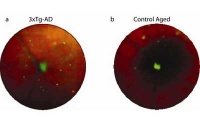The researchers, led by profs Francesca Cordeiro and Stephen Moss, have demonstrated a new technique that enables retinal, and therefore brain cell death, to be directly measured in real time.
The method, demonstrated in an animal model, could not only refine diagnosis of neurodegenerative disorders and help track disease progress, it could also aid the assessment and development of new treatments.
The technique uses fluorescent markers that attach themselves to the relevant cells and indicate the stage of cell death. The retina is then observed using a customised laser ophthalmoscope. Until now, this kind of technique has only been used in cells in the laboratory, rather than in live animals. The researchers say that this is the first ever in vivo demonstration of retinal nerve cell death in Alzheimer’s disease.
Cordeiro, from the UCL Institute of Ophthalmology, said: ‘The death of nerve cells is the key event in all neurodegenerative disorders — but until now it has not been possible to study cell death in real time. This technique means we should be able to directly observe retinal nerve cell death in patients, which has a number of advantages in terms of effective diagnosis. This could be critically important since identification of the early stages could lead to successful reversal of the disease progression with treatment.’
Currently, the biggest obstacle to research into new treatments for neurodegenerative diseases is the lack of a technique where the brain’s response to new treatments can be directly assessed — the new technique could potentially help overcome this.
Cordeiro’s team is using the same technique to detect and assess glaucoma, and will be conducting its first patient trials later this year.
She added: ‘The equipment used for this research was customised to suit animal models but is essentially the same as is used in hospitals and clinics worldwide. It is also inexpensive and non-invasive, which makes us fairly confident that we can progress quickly to its use in patients.
‘Few people realise that the retina is a direct, albeit thin, extension of the brain. It is entirely possible that in the future a visit to a high-street optician to check on your eyesight will also be a check on the state of your brain.’
The research was supported by funding from the Wellcome Trust and the Foundation Fighting Blindness.
The project has also been supported by UCL Business proof-of-concept funds and two patents have been filed around the technology.

Image: Retinal images of a living 14-month Alzheimer Triple Transgenic mouse (a) compared to an aged control living mouse (b). Many more retinal nerve cells are in the early phase of apoptosis (green spots) in the Alzheimer mouse





Swiss geoengineering start-up targets methane removal
No mention whatsoever about the effect of increased methane levels/iron chloride in the ocean on the pH and chemical properties of the ocean - are we...